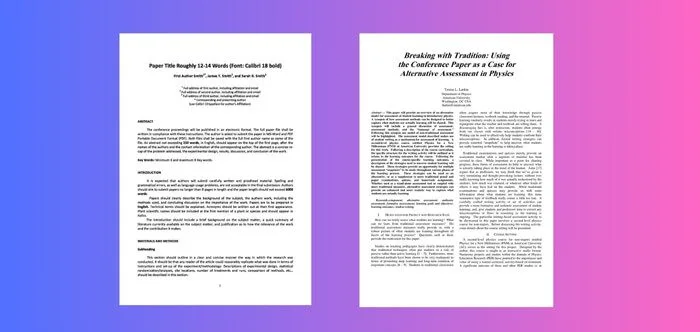Conferences are major platforms where academics, researchers, and professionals gather to share knowledge, ideas, and advancements in their fields. They play a crucial role in the dissemination of new research and encourage collaboration and networking. Regarding the submission process, many authors often wonder: Do conferences give notification of rejection?
Yes, conferences typically inform authors about their paper’s status through digital channels, detailing acceptance, rejection, or revisions. Understanding this process, including timing, content, and follow-up opportunities, helps authors navigate and improve future submissions effectively.
Whether it’s revising the paper for future submissions or finding an alternative publication venue, feedback can be invaluable. Read on to explore more about the significance of this process and how it can assist your academic career.
Conference Paper – What is it About?
A conference paper is a form of academic writing presented at scholarly meetings, often centered around a specific topic or research area. These papers are usually short, focused, and represent the latest developments in a particular field. They provide a platform for researchers to share findings, engage in discussions, and receive feedback from peers.
In most cases, papers submitted to a conference arranged by a reputable event organizer are subject to peer review before acceptance. This ensures that the content is of high quality and contributes meaningfully to the existing body of knowledge. They are often accompanied by presentations, allowing the author to expand on key points and engage with the audience.
The significance of conference papers lies in their ability to promote academic collaboration and networking. They often lead to further research and publications in journals. However, not all submissions are accepted; some may receive a conference paper rejection notification, highlighting the need for authors to revise and improve their work. Despite this, these papers can still influence future studies and advance understanding in various academic disciplines.
Types of Conference Papers You Can Submit in a Conference
Submitting a conference paper is a significant step in sharing research and ideas within the academic community. Different types of conference papers cater to various research needs and presentation styles. Let’s explore the types of conference papers you can submit to a conference.
Full-Length Research Papers
These papers offer a comprehensive account of original research. They include detailed methodology, data analysis, and discussion of results. Full-length papers are ideal for presenting extensive studies and are often published in conference proceedings.
Short Papers or Extended Abstracts
A concise summary of the research work is presented here. Short papers highlight the main idea, methodology, and key findings, but in a more brief format. They’re suitable for ongoing research or initial findings.
Position Papers
Here, authors present an argument or opinion on a specific topic. Position papers are less about presenting new research and more about discussing perspectives or theories. They’re great for sparking debate and discussion.
Case Studies
This format is for detailed analysis of a specific case, often in real-world contexts. Case studies focus on practical application rather than theoretical discussion. They are valuable for sharing experiences and lessons learned.
Review Papers
These papers summarize existing literature on a particular topic. Review papers summarize current knowledge, identify trends, and often suggest areas for future research. They’re ideal for providing a complete overview of a subject.
Poster Presentations
A poster presentation provides a visual representation of research. They summarize the research question, methods, and findings in a visually appealing format. This type is interactive, as it encourages viewers to engage directly with the presenter.
Each type of conference paper serves a unique purpose in academic research. Choosing the right format for your research ensures effective communication and contributes to the ongoing development of knowledge in your field.
Do Conferences Give Notification of Rejection?
Yes, conferences typically inform authors about the status of their paper submissions. Understanding how and when these notifications are given can help authors better navigate the submission process. Explore more about this process below:
Standard Notification Process
Conferences generally follow a standard procedure to notify authors about the status of their submissions. After the review process, authors receive an email or a notification through the conference’s submission platform. This communication informs them whether their paper has been accepted, rejected, or requires revisions. This formal notification ensures transparency and allows authors to plan their next steps accordingly.
Timing of Notifications
The timing of rejection notifications varies by conference, but it typically occurs several weeks after the submission deadline. Most conferences follow a predetermined schedule, with clear timelines for communication. Authors should be aware of these timelines to manage their expectations and prepare for any outcomes.
Content of the Notification
A rejection notification usually includes a brief explanation of the decision. While some conferences provide detailed feedback from reviewers, others may offer only a general statement. Regardless, the notification serves as the official communication regarding the paper’s status, and authors are encouraged to carefully review its contents.
Importance of Receiving a Rejection Notice
Even though receiving a rejection notice is disappointing, it is an essential part of the academic process. It allows authors to understand where their work may need improvement. Without such notifications, authors would remain uncertain about the status of their submissions, hindering their ability to make timely revisions or pursue alternative publication options.
Channels for Rejection Notification
Most conferences utilize digital channels, such as email or online submission portals, to communicate rejection notices. This ensures that the notification is received promptly and securely. Authors should regularly check these channels, especially as the decision date approaches, to avoid missing important updates.
Follow-up After Receiving a Notification
After receiving a rejection notification, authors are often encouraged to seek clarification or further feedback if it’s not initially provided. Some conferences allow for this communication, giving authors a chance to understand the reasons behind the rejection more deeply. This follow-up can be valuable for improving future submissions.
Receiving a rejection notification is a standard part of the conference submission process. It provides clarity on the status of your work, allowing you to take informed next steps in your academic journey.
What to Do If You Get a Notification of Rejection?
Receiving a rejection from a conference can initially feel disappointing, but it often serves as a turning point for academic and professional growth. It is crucial to respond strategically to setbacks. Here’s a step guide on what to do if you get a rejection notification:
Step 1: Process the Feedback
Absorb the reviewers’ feedback with an open mind. Reflect on their comments critically, but don’t take them personally. This feedback is a valuable tool for identifying areas of your research that can be strengthened or clarified.
Step 2: Revise Your Paper
After receiving feedback, revise your paper methodically. Pay extra attention to the weaknesses pointed out by the reviewers. By improving these areas not only improves your paper but also your skills as a researcher.
Step 3: Seek Additional Opinions
Reach out to mentors or colleagues for their perspectives on the feedback. They might provide additional insights or alternative approaches to the issues raised. This collaborative review process can further refine your paper.
Step 4: Explore Other Conferences
Research other conferences that might be a better fit for your paper. Each conference has a unique focus and audience, and finding the right one can increase the chances of your paper being accepted. Additionally, keep an eye on any conference cancellation letter notifications, as this may open up new submission opportunities elsewhere.
Step 5: Stay Resilient and Positive
Maintain a positive outlook and resilience. Rejection is a natural part of the academic journey and can be a catalyst for personal and professional growth. Keep refining your work and staying committed to your research goals.
By following these steps, you will be able to turn your conference paper rejection into a valuable learning experience that will pave the way for your future success in your academic career.
Tips to Effectively Submit Your Conference Paper
Submitting a conference paper is a critical step in sharing your research with the academic community. To increase the chances of acceptance, it’s necessary to understand and follow specific guidelines. Here are some effective tips to guide you through the submission process:
Know the Conference Theme
Before writing, thoroughly understand the conference’s theme and scope. Ensure your paper aligns with these themes to increase relevance. Customizing your paper to fit the conference’s focus can greatly improve your chances of acceptance.
Follow Submission Guidelines
Each conference has specific submission guidelines. Follow strictly these instructions, including formatting, word count, and submission deadlines. Ignoring these guidelines can lead to immediate rejection, regardless of your paper’s quality.
Focus on Quality Content
Your paper should present original, well-researched content. Prioritize clarity, conciseness, and a logical flow of ideas. A paper that is coherent, well-structured, and insightful stands a better chance of being accepted.
Get Peer Feedback
Before submitting, seek feedback from peers or mentors. Fresh eyes can spot errors or areas needing improvement. Constructive criticism from colleagues can significantly enhance the quality of your paper.
Proofread and Edit
Make sure you proofread your paper to eliminate grammatical errors and typos. An error-free, well-written paper reflects your professionalism and attention to detail. Consider using professional editing services if necessary.
Understand Deadlines
Be mindful of the reasons behind fake conference deadlines that some organizers might use to attract submissions. Always verify deadlines through official sources to ensure you have accurate information, helping you avoid potential issues and unnecessary stress.
Frequently Asked Questions
Understanding how conferences handle rejection notifications can help authors better prepare for the outcomes of their submissions. Below, we address some key aspects of this process that are often ignored.
How Do Conferences Handle Notification Timelines?
Conferences typically follow a set timeline for notifying authors about the status of their submissions. These timelines are usually published well in advance, allowing authors to know when they can expect a decision. Timely notifications help authors plan their next steps, whether it’s revising their paper or seeking alternative publication venues.
What Are the Common Methods Used to Send Rejection Notifications?
A rejection notification is usually sent via email or a submission portal by conferences. These methods ensure that the communication is direct and prompt. Authors should regularly check these channels around the notification period to avoid missing important updates.
How Detailed Is the Feedback in Rejection Notifications?
The level of detail in feedback provided with rejection notifications varies by conference. Some conferences offer detailed comments from reviewers, while others may provide only a brief explanation. Regardless of the detail, this feedback is crucial for understanding the reasons behind the decision and for improving future submissions.
Are There Follow-up Opportunities After Receiving a Rejection?
Many conferences allow authors to seek additional feedback or clarification after receiving a rejection notification. Engaging in this follow-up can provide deeper insights into the reviewers’ concerns and help refine the paper for future submissions. This step is especially valuable for authors aiming to improve their research.
How Can Rejection Notifications Impact Future Submissions?
Receiving a rejection notification can be a learning experience that positively impacts future submissions. Authors who carefully review the feedback and make necessary improvements are often better prepared for their next submission. This process contributes to ongoing professional development and enhances the quality of future research endeavors.
Conclusion
A path of learning and development awaits researchers as they enter the world of academic conferences. The process of submitting and receiving feedback on conference papers hones skills and deepens understanding.
In this context, the query do conferences give notification of rejection is particularly relevant, confirming that such notifications are a standard and necessary part of the academic process. They offer valuable insights for researchers, guiding them in refining their work for future success.
These experiences, while challenging, are essential to the academic experience. They encourage flexibility, adaptability, and continual development, essential qualities for any successful scholar in today’s academics.








